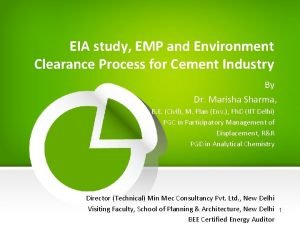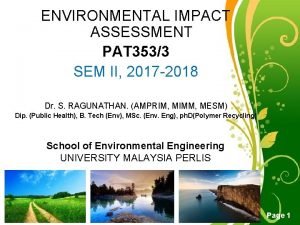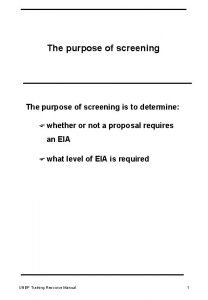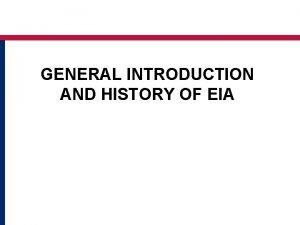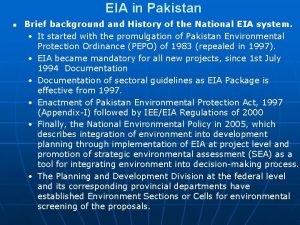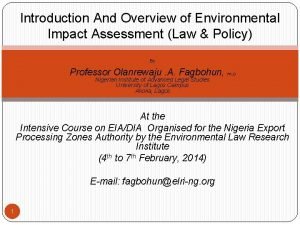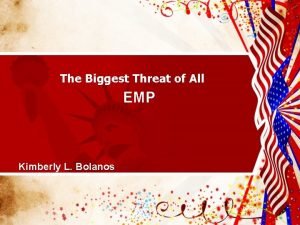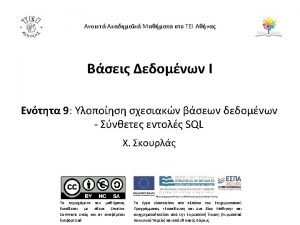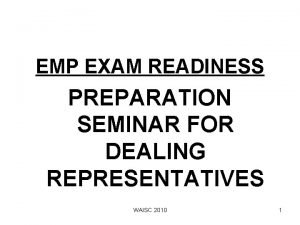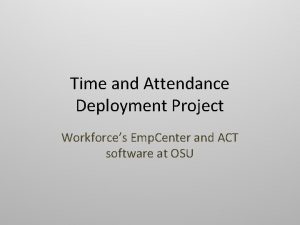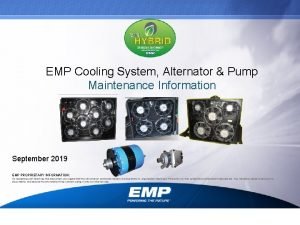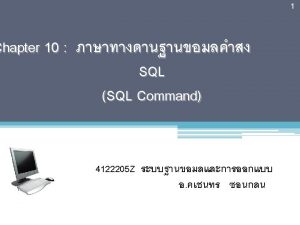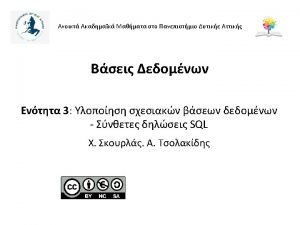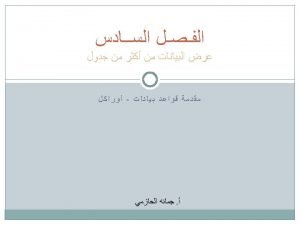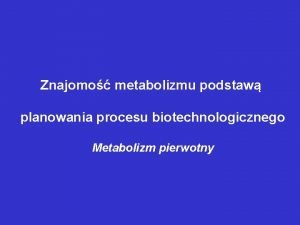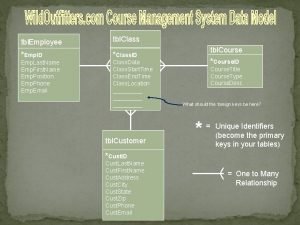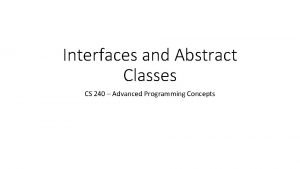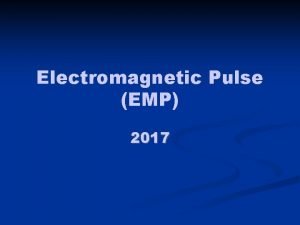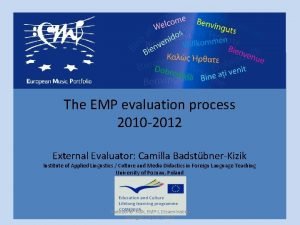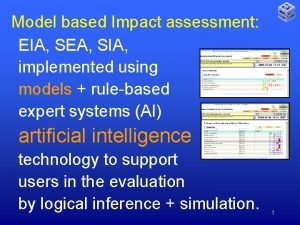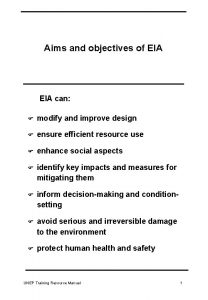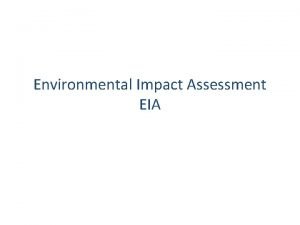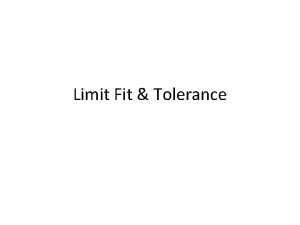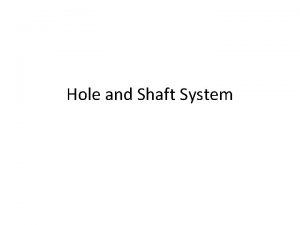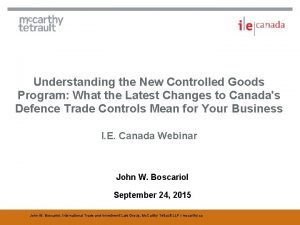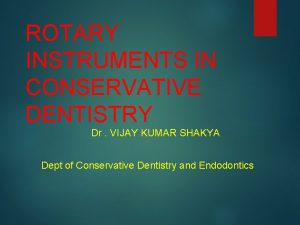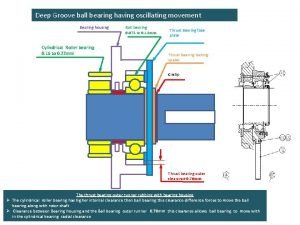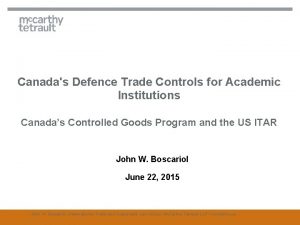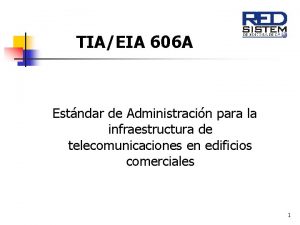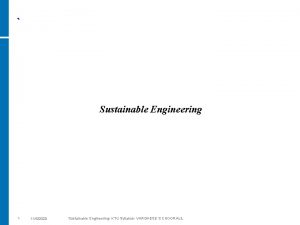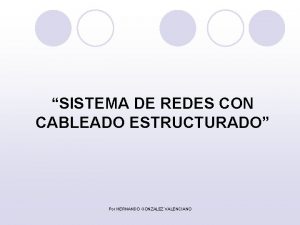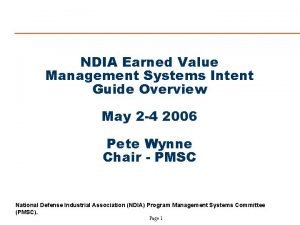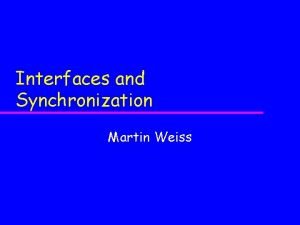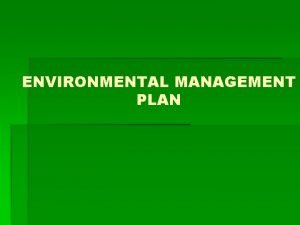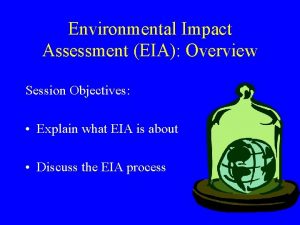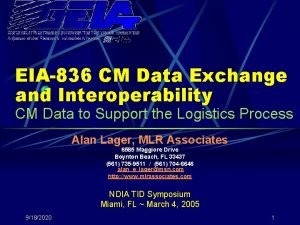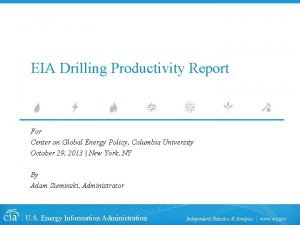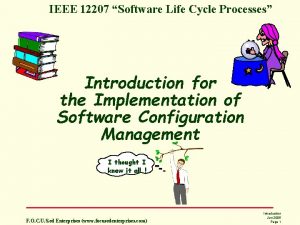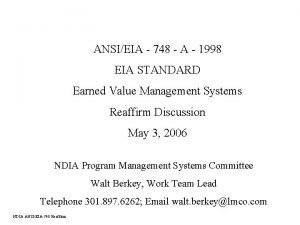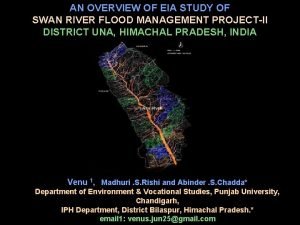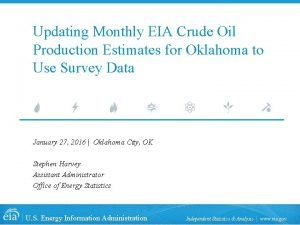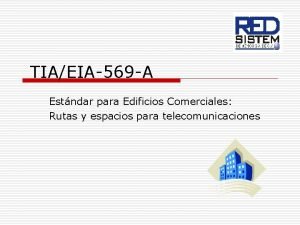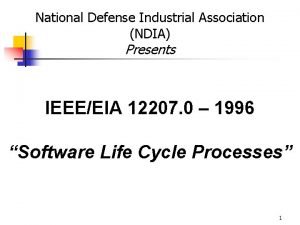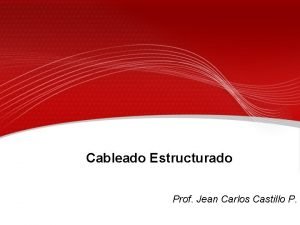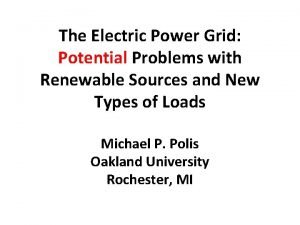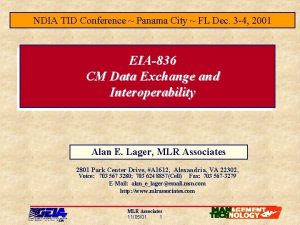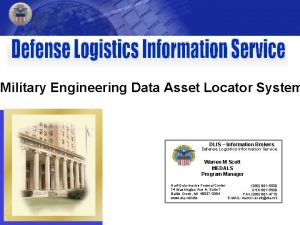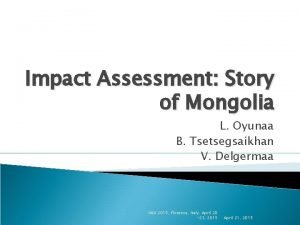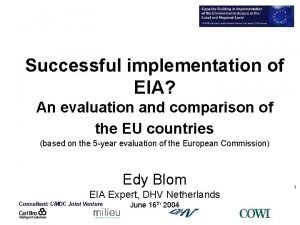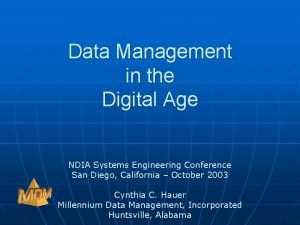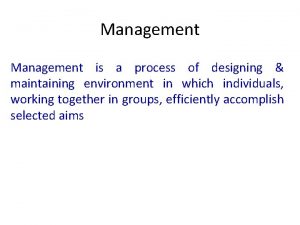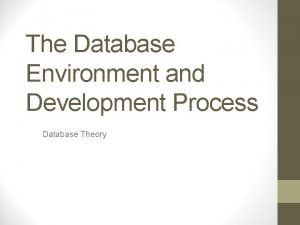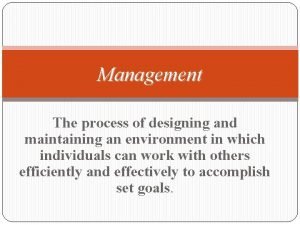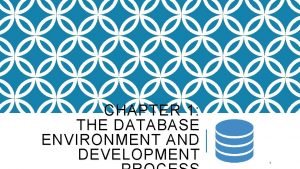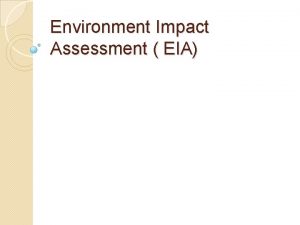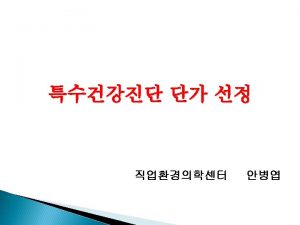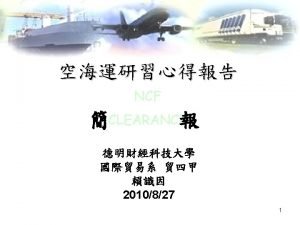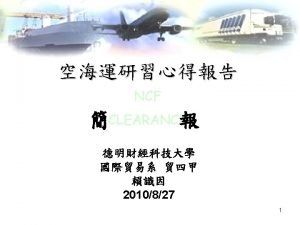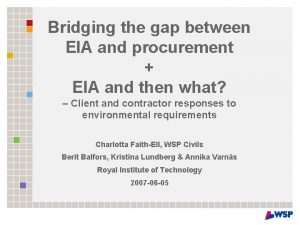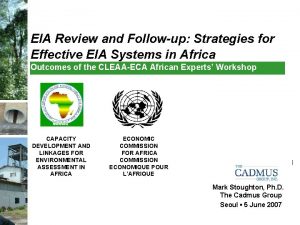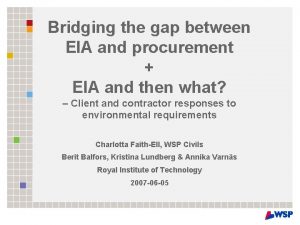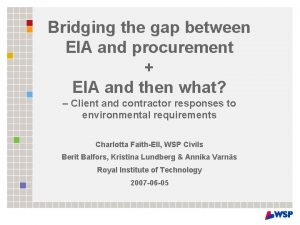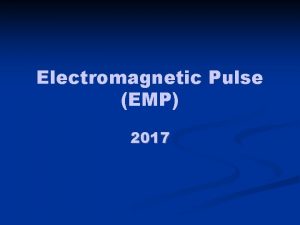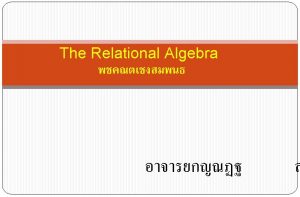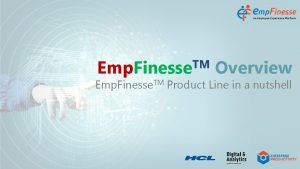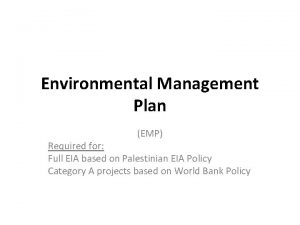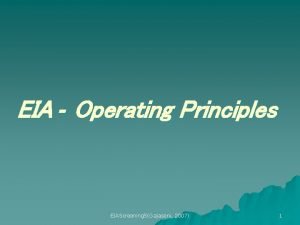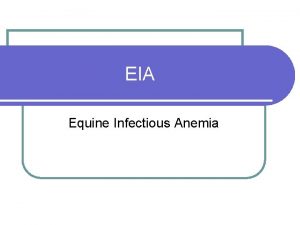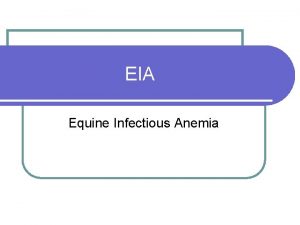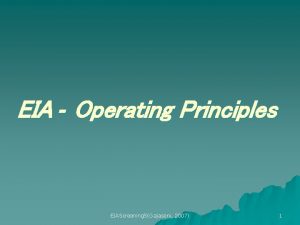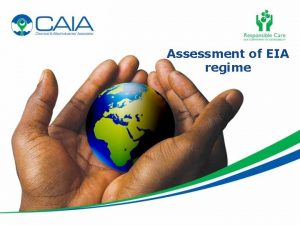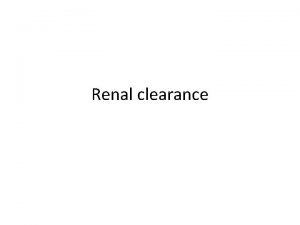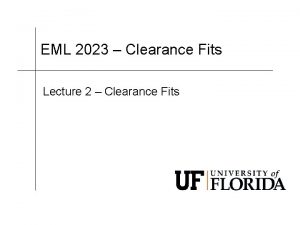EIA study EMP and Environment Clearance Process for




























































































- Slides: 92

EIA study, EMP and Environment Clearance Process for Cement Industry By Dr. Marisha Sharma, B. E. (Civil), M. Plan (Env. ), Ph. D (IIT Delhi) PGC in Participatory Management of Displacement, R&R PGD in Analytical Chemistry Director (Technical) Min Mec Consultancy Pvt. Ltd. , New Delhi Visiting Faculty, School of Planning & Architecture, New Delhi BEE Certified Energy Auditor 1

EIA Notification dt. 14. 09. 2006, Schedule (& amendment 23. 11. 2016) Project or Activity 3(b) Cement plants Category with threshold limit A B > 1. 0 million tonnes/annum production capacity <1. 0 million tonnes/annum production capacity. All Stand alone grinding units Conditions if any General Condition shall apply Note: 1. Fuel for cement industry may be coal, petcoke, mixture of coal and petcoke and co-processing of waste provided it meets the emission standards. 2. The manufacturing of composite cement by plants having environmental clearance for manufacturing Ordinary Portland Cement(OPC), Portland Pozzolana Cement(PPC) and Portland Slag Cement(PSC) shall be exempt provided the production is within sanctioned capacity. ”; 2

EIA Notification dt. 14. 09. 2006, Schedule (& amendment 23. 11. 2016) General Condition (GC): (as amended vide notification dated 25. 06. 2014) Any project or activity specified in Category ‘B’ will be treated as Category A, if located in whole or in part within 5 km from the boundary of: (i) Protected Areas notified under the Wild Life (Protection) Act, 1972, (ii) Critically Polluted areas as notified by the Central Pollution Control Board from time to time, (iii) Notified Eco-sensitive areas (under sub section (2) of Section 3 of EPA 1986), (iv) inter-State boundaries and international boundaries. provided that for River Valley Projects specified in item l(c), Thermal Power Plants specified in item I (d), Industrial estates/parks/complexes/areas, export processing zones (EPZs), Special Economic Zones (SEZs), biotech parks, leather complexes specified in item 7(c) and common hazardous waste treatment, storage and disposal facilities (TSDFs) specified in item 7( d), the appraisal shall be made at Central level even if located within 10 km. 3

Categories of Projects for Environmental clearance EIA Notification 2006 dt 14. 09. 2006 Category A B 1 Category B B 1 Amendment dated 15 -01 -2016 Amendment dated 09 -12 -2016 B 2 - mining of minor minerals ≤ 5 ha ( to be considered by DEIAA, subject to several other conditions) * No more Category B 2 in construction * Instead Other building categories ( ≥ 20, 000 sq. m upto 1, 50, 000 sq. m) Building Category "1" (5, 000 to < 20, 000 sq. m) 4

Clearance Process for Category A Project 5

Clearance Process for Category A Project. . contd. . 6

Simplified flow diagram-Category A (Cement Plant) A Form 1, PFR Submit Reply Preparation of Final EIA/EMP report after incorporating points raised in PH Mo. EF&CC Presentation Querry EAC (Industry-1) Issues TOR (Terms of Reference) Baseline monitoring for meteorology, air, water, soil, noise, flora, fauna, etc (3 months, non monsoon only) Preparation of Draft EIA/EMP report Reply Querry Submit to Mo. EF&CC Appraisal by EAC recommends or rejects for environmental clearance (EC) Mo. EF&CC submission to SPCB Conduct of Public Hearing rejection letter or EC approval letter issued Minutes of PH A 7

Clearance Process for Category B Project 8

Clearance Process for Category B Project. . . contd. . 9

Simplified flow diagram- Category B 1 (Cement Plants/ Grinding Units) A Form 1, PFR Submit Reply SEIAA Presentation Querry SEAC of the State of Project Issues TOR (Terms of Reference) Baseline monitoring for meteorology, air, water, soil, noise, flora, fauna, etc (3 months, non monsoon only) Preparation of Draft EIA/EMP report submission to SPCB Conduct of Public Hearing Preparation of Final EIA/EMP report after incorporatimg points raised in PH Reply Querry Submit to SEIAA Appraisal by SEAC recommends or rejects for environmental clearance (EC) SEIAA rejection letter or EC approval letter issued Minutes of PH A 10

B 1 vs B 2 A project will be B 1 or B 2 • depending upon the nature and location specificity of the project • To be decided by SEAC after scrutiny of the applications Situations which might be considered for Category B 2 are: • Enhancement of production capacity of existing plants, essentially by utilizing the excess capacity of the machineries for size reduction and pyroprocessing, or adding additional capacity for some unit operations to match the existing spare capacity of others. In all such cases, increased quantity of limestone should be available from the existing mines and increased emissions shall be taken care of by the installed pollution control devices or additional ones. • Expansion /modernization of existing cement plants upto 25% capacity expansion may be considered as Category B 2, if the EAC/SEAC is satisfied by the methodologies/ technologies proposed by the project proponent to control the significant impacts on the surrounding environment. • Adoption of waste materials as substitute for fossil fuels or raw materials (AFR) shall not require fresh EIA, but will be subject to stipulations of CPCB, BIS and other authorities. 11

Clause 7(ii) of EIA Notification 2006, as amended on 23. 11. 2016 7 (ii) Prior Environmental Clearance (EC) process for Expansion or Modernization or Change of product mix in existing projects (a) All applications seeking prior environmental clearance for expansion with increase in the production capacity beyond the capacity for which prior environmental clearance has been granted under this notification or with increase in either lease area or production capacity in the case of mining projects or for the modernisation of an existing unit with increase in the total production capacity beyond the threshold limit prescribed in the Schedule to this notification through change in process and or technology or involving a change in the product –mix shall be made in Form I and they shall be considered by the concerned Expert Appraisal Committee or State Level Expert Appraisal Committee within sixty days, who will decide on the due diligence necessary including preparation of Environment Impact Assessment and public consultations and the application shall be appraised accordingly for grant of environmental clearance. . . contd. 12

Clause 7(ii) of EIA Notification 2006, as amended on 23. 11. 2016. . contd. . (b) Any change in configuration of the plant from the environmental clearance conditions during execution of the project after detailed engineering shall be exempt from the requirement of environmental clearance, if there is no change in production and pollution load. The project proponent shall inform the Ministry of Environment, Forest and Climate Change / State Level Environment Impact Assessment Authority and the concerned State Pollution Control Board. (c) Any change in product-mix, change in quantities within products or number of products in the same category for which environmental clearance has been granted shall be exempt from the requirement of prior environmental clearance provided that there is no change in the total capacity sanctioned in prior environmental clearance granted earlier under this notification and there is no increase in pollution load. The project proponent shall follow the procedure for obtaining No Increase in Pollution Load certificate from the concerned State Pollution Control Board as per the provisions given in Appendix –XIV. ”; 13

Simplified flow diagram- Category B 2 / 7(ii) (Cement Plants/ Grinding Units) Form 1, PFR Submit SEIAA/ EAC Response Querry Presentation to SEAC/ EAC no querry Rejected Recommended for EC SEIAA/ MOEFCC EC Letter or Rejection letter 14

Requirements & Appraisal level for various Category projects Doccuments required Category of project Form 1 A (all except 8 b) √ A ( for 8 b) √ Form PFR 1 A Coceptual Plan Self declaration Certificate QBEA √ PH EIA √ Level of for appraisal √ Mo. EF&CC B 1 (except item 8(b) of Schedule to EIA Notification) √ B 1 8(b) i. e construction √ B 2 (all except construction) √ √ √ √ √ Other buildings √ Category "1" Building √ √ Mo. EF&CC or SEIAA √ SEIAA Dev. Authority √ √ Dev. Authority 15

Form 1 • EIA Notification no. SO 1533 dt. 14. 09. 2006 • Amendment no. SO 3067(E) dated 01. 12. 2009 • Combined form Pre-feasibility Report Circular no. J-11013/41/2006 -IA. II(I) dated 30. 12. 2010 Greenfield projects- Siting guidelines to be followed and evaluation of alternatives is essential. The project location can attract additional statutory clearances such as CRZ, NBWL, Forest clearance, NHAI, etc. It can also trigger protests from locals. Integrated & interlinked projects- consideration as per OM dt. 24. 12. 2010 16

Online filling of Form-1 • Register online • Apply for TOR. Documents/ files required: 1. Fill form 1 online. Input box will receive maximum 500 characters. Therefore, make attachments where required and put in file at point 8 below. 2. 3. 4. 5. 6. 7. 8. 9. Annexure-GPS file (kmz file) Annexure-Survey of india toposheet. pdf Annexure-Brief summary of project. pdf Annexure-TOR file. pdf Annexure-scanned copy of covering Letter. pdf Annexure-PFR. pdf Annexure-Additional attachments. pdf Annexure-Uploaded Approval of mining plan. pdf (in case of cement plant & limestone mine are an integrated project) 10. Authorisation letter Note : be alert to file sizes permitted for upload 17

Terms of Reference (TOR) • Validity of TOR • Generic TOR in respect of Industry Sector • Additional Terms of Reference (TOR) for Cement Plants (next slide) • In case of additional units in the cements plant, typically a captive power plant, additional TORs will be specified 18

Additional Terms of Reference (TOR) for Cement Plants 1. Limestone and coal linkage documents along with the status of environmental clearance of limestone and coal mines 2. Quantum of production of coal and limestone from coal & limestone mines and the projects they cater to; 3. Present land use shall be prepared based on satellite imagery. High-resolution satellite image data having 1 m-5 m spatial resolution like quickbird, Ikonos, IRS P-6 pan sharpened etc. for the 10 Km radius area from proposed site. The same shall be used for land used/land-cover mapping of the area. 4. If the raw materials have trace elements, an environment management plan shall also be included. 5. Plan for the implementation of the recommendations made for the cement plants in the CREP guidelines must be prepared. 6. Energy consumption per ton of clinker and cement grinding 7. Provision of waste heat recovery boiler 8. Arrangement for co-processing of hazardous waste in cement plant. 9. Trace metals in waste material especially slag. 19

EIA / EMP REPORT GENERIC STRUCTURE OF ENVIRONMENTAL IMPACT ASSESSENT DOCUMENT Chapter No. 1 Title Contents Introduction • Purpose of the report • Identification of project & project proponent • Brief description of nature, size, location of the project and its importance to the country, region • Scope of the study – details of regulatory scoping carried out (As per Terms of Reference) 20

EIA / EMP REPORT Chapter Title No. 2 Project Description Contents • Condensed description of those aspects of the project (based on project feasibility study), likely to cause environmental effects. • Type of project • Need for the project • Location (maps showing general location, specific location, project boundary & project site layout) • Size or magnitude of operation (incl. Associated activities required by or for the project • Proposed schedule for approval and implementation • Technology and process description • Project description. Including drawings showing project layout, components of project etc. Schematic representations of the feasibility drawings which give information important for EIA purpose • Description of mitigation measures incorporated into the project to meet environmental standards, environmental operating conditions, or other EIA requirements (as required by the scope) • Assessment of New & untested technology for the risk of technological failure 21

EIA / EMP REPORT Chapter Title No. Contents 3 Description of the Environment • Study area, period, components & methodology • Establishment of baseline for valued environmental components, as identified in the scope • Base maps of all environmental components 4 Anticipated • Details of Investigated Environmental impacts due to project Environmental location, possible accidents, project design, project construction, Impacts regular operations, final decommissioning or rehabilitation of a & completed project Mitigation • Measures for minimizing and / or offsetting adverse impacts Measures identified • Irreversible and Irretrievable commitments of environmental components • Assessment of significance of impacts (Criteria for determining significance, Assigning significance) • Mitigation measures 22

EIA / EMP REPORT Chapter Title No. Contents 5 Analysis of Alternatives (Technology & Site) • In case, the scoping exercise results in need for alternatives: • Description of each alternative • Summary of adverse impacts of each alternative • Mitigation measures proposed for each alternative and • Selection of alternative 6 Environmental Monitoring Program Technical aspects of monitoring the effectiveness of mitigation measures (incl. Measurement methodologies, frequency, location, data analysis, reporting schedules, emergency procedures, detailed budget & procurement schedules) 7 Additional Studies • Public Consultation • Risk assessment • Social Impact Assessment. R&R Action Plans 8 Project Benefits • Improvements in the physical infrastructure • Improvements in the social infrastructure • Employment potential –skilled; semi-skilled and unskilled • Other tangible benefits 23

EIA / EMP REPORT Chapter Title No. Contents 9 Environmental Cost Benefit Analysis If recommended at the Scoping stage 10 EMP Description of the administrative aspects of ensuring that mitigative measures are implemented and their effectiveness monitored, after approval of the EIA 11 Summary & • Overall justification for implementation of the project Conclusion • Explanation of how, adverse effects have been (This will constitute mitigated the summary of the EIA Report ) 12 Disclosure of The names of the Consultants engaged with their Consultants engaged brief resume and nature of Consultancy rendered 24

Summary of EIA / EMP report (EIA Notification 2006) The Summary EIA shall be a summary of the full EIA Report condensed to ten A-4 size pages at the maximum. It should necessarily cover in brief the following Chapters of the full EIA Report: 1. Project Description 2. Description of the Environment 3. Anticipated Environmental impacts and mitigation measures 4. Environmental Monitoring Programme 5. Additional Studies 6. Project Benefits 7. Environment Management Plan 25

Summary of EIA / EMP report (Directions from EAC, Industry-I, MOEF&C) More elaborate directions: Executive summary of the report in about 8 -10 pages incorporating the following: i. Project name and location (Village, Dist, State, Industrial Estate (if applicable) ii. Products and capacities. If expansion proposal, then existing products with capacities and reference to earlier EC. iii. Requirement of land, raw material, water, power, fuel, with source of supply (Quantitative) iv. Process description in brief, specifically indicating the gaseousemission, liquid effluent and solid and hazardous wastes. Materials balance shall be presented. v. Measures for mitigating the impact on the environment and mode of discharge or disposal. vi. Capitalcost of the project, estimated time of completion vii. Site selected for the project – Nature of land – Agricultural (single/double crop), barren, Govt/private land, status of is acquisition, nearby (in 2 -3 km. ) water body, population, with in 10 km other industries, forest, eco-sensitive zones, accessibility, (note – in case of industrial estate this information may not be necessary) contd. . 26

Summary of EIA / EMP report (Directions from EAC, Industry-I, MOEF&C). . contd. . viii. Baseline environmental data – air quality, surface and ground water quality, soil characteristic, flora and fauna, socio-economic condition of the nearby population ix. Identification of hazards in handling, processing and storage of hazardous material and safety system provided to mitigate the risk. x. Likely impact of the project on air, water, land, flora-fauna and nearby population xi. Emergency preparedness plan in case of natural or in plant emergencies xii. Issues raised during public hearing (if applicable) and response given xiii. CSR plan with proposed expenditure. xiv. Occupational Health Measures xv. Post project monitoring plan 27

Generic approach for accomplishing EIA studies Chapter 3 of EIA Chapter 4 of EIA 28

Chapter 3 Description of the Environment 29

Description of Evironment • Data collection – secondary – primary • Data collection for according to location (terrestrial/ shore) and status (existing/ new): – Air (Ambient, workplace) – Water (surface, ground, marine) – Noise (Ambient, workplace) – Soil and Land use – Ecology (flora, fauna; terrestrial/ aquatic/ marine) – Topography, drainage – Climate, micro-meteorology – Traffic – Solid waste – Demography, Socio economics, public health – Protected areas (ecological, archaelogical) – Industries 30

Guidance For Assessment Of Baseline Components And Attributes PM 2. 5 Typically recommended =8 31

Guidance For Assessment Of Baseline Components And Attributes 32

Guidance For Assessment Of Baseline Components And Attributes 33

Guidance For Assessment Of Baseline Components And Attributes 34

Guidance For Assessment Of Baseline Components And Attributes 35

Guidance For Assessment Of Baseline Components And Attributes 36

Chapter 4 Anticipated Environmental Impacts & Mitigation Measures 37

Types of Impacts 38

Types of Impacts • Direct impacts : Direct impacts occur through direct interaction of an activity with an environmental, social, or economic component. For example, a discharge of cement industry or an effluent from the Effluent Treatment Plant (ETP) into a river may lead to a decline in water quality in terms of high biological oxygen demand (BOD) or dissolved oxygen (DO) or rise of water toxins. • Indirect impacts : Indirect impacts on the environment are those which are not a direct result of the project, often produced away from or as a result of a complex impact pathway. The indirect impacts are also known as secondary or even tertiary level impacts. For example, ambient air SO 2 rise due to stack emissions may deposit on land as SO 4 and cause acidic soils. • Cumulative impacts • Induced impact 39

Significance of impact • To establish, the level of significance for each identified impact, a threestage analysis may be referred: – First, an impact is qualified as being either negative or positive. – Second, the nature of impacts such as direct, indirect, or cumulative is determined using the impact network – Third, a scale is used to determine the severity of the effect; for example, an impact is of low, medium, or high significance. 40

Manufacturing Processes • The cement manufacturing involves mining, crushing, grinding of raw materials, blending of raw meal, calcining the materials in a rotary kiln, cooling the resulting clinker, mixing the clinker with gypsum, and miling, storing, bagging the finished cement. • Raw material used to make cement may be divided into four basic components: lime(calcareous), silica(siliceos), alumina (argillaceous), and iron (ferriferous). • There are four main process routes for the cement manufacturing Dry process- The raw materials are ground and dried to raw meal in the from of a flowable powder. the dry raw meal is fed to the pre-heater or precalciner kiln or, more rarely, to a long dry kiln. Semi-Dry process- Dry raw materials is pelletized with water and fed into a grate preheater before the kiln or to a long kiln equipped with crosses. Semi-Wet process- The slurry is first dewatered in filter process. The filter cake is extruded into pellets and fed either to a grate pre-heater or directly to a filter cake drier for raw meal production. Wet Process- the raw materials (often with high moisture content) are ground in water to form a pumpable slurry. The slurry is either fed directly into the kiln or first to slurry drier. 41

CEMENT MANUFACTURING PROCESS Limestone Quarry Crusher Limestone Storage Clay Quarry Crusher Clay storage Kiln Cooler Pre-heater Pre-calciner Additives (e. g. iron ore) mixer and raw meal grinding Kiln feeder Raw meal storage Clinker Storage Gypsum Storage Additives Storage Pre-heater (Fly ash, slag, Pre-calciner etc) Cement grinding Cement silos Bulk shipping Cement bagging Bag shipping 42

RAW MATERIAL INPUT AND POLLUTION OUTPUTS IN PRODUCTION LINE NOx The main environment issues associated with cement projects primarily include the following: • Exploitation of natural resources for raw materials • Energy consumption and fuels • Air emission including dust • Wastewater • Solid waste generation • Noise • Vibration 43

A. Consumption of raw materials 5

B. Energy Consumption Thermal and Electrical consumption in Dry Process Cement Plants in India Specific Thermal Energy consumption in Indian Cement Sector 5

Table: Specific Electric Energy consumption (k. Wh/t of Material) 46

Use of high calorific value wastes as fuel in cement kiln CPCB, on the basis of field trials, have recommended use of hazardous wastes like ETP sludge from dyes and dye intermediates, tyre chips, paint sludge, Toulene-Die-Isocynate tar residue and refinery sludge as supplementary fuels in cement kilns. Compliance with notified emission norms for hazardous wastes in incinerators has been reported. 47

C. Air emissions • During operation main pollutants- Dust and gaseous emission • Air emissions are generated by • handling and storage of raw, • intemediated and final materials and • by the operation of kiln systems, clinker coolers, and mills. • main releases from the production of cement are releases to air from the kiln system derived from the chemical and physical reactions involving raw material and consumption of fuels. • The main gaseous pollutants relevent to cement manufacture are: Oxides of Nitrogen (NOx) and other nitrogen compounds Sulphur dioxide (SO 2) and other sulphur compounds carbon oxides (CO and CO 2) • Secondary pollutants /; VOCs, hydrocarbons, dioxins, furans, heavy metals. 48

Point Sources from a Cement Manufacturing Process 49

PM Emission factors with and without APCD for cement Manufacturing Industries in India (Dry process) PM Emission factors with and without APCD for cement Manufacturing Industries in India (Wet process) 50

Table: NOx emission Fctors and Concentrations SOx emission Fctors and Concentrations 51

Carbon oxides • Total CO 2 emission per T of cement range from 0. 85 to 1. 15 T, the approximate contribution being; Calcination - 50 -55% Fuel consumption-40 -50% Electricity-0 -10% • CO forms due to insufficient supply of oxygen in the air-fuel mix. since complete combustion of fuel is always attempted with somewhat excess air, normally, no trace of CO should be found in the exit gas; it is not allowed to exceed 1000 ppm 52

Secondary pollutants Volatile organic compounds (VOC) : The probability of VOCs appearing in exhaust gases is low, as they are oxidized in low temperatures, much below those prevailing even in Calciners. Dioxins and furans : Dioxins and furans are formed while using waste derived fuels (WDF), when chlorine in wastes in the form of precursors such as PVC, Na. Cl or chlorobenzenes combine with other chemicals at low temperatures. Dioxin and furan emission concentrations are low regardless of the type of fuel used and measurements • Heavy metals : The transfer behaviour of heavy metals in cement manufacturing process depends on their volatility, and is generated from the use of raw materials, fossil fuels, and WDF. Metal compounds can be categorized into three classes, based on the volatilities of the metals and their salts: Metals which are or have compounds that are refractory or non- or low-volatile: Ba, Be, Cr, As, Ni, V, Al, Ti, Ca, Fe, Mn, Cu and Ag; Metals that are or have compounds that are semi-volatile: Sb, Cd, Pb, Se, Zn, K and Na; Metals that are or have compounds that are volatile: Hg and Tl. • Low-volatile heavy metals tend to become incorporated in very stable chemical compounds in the clinker. • Semi-low volatile heavy metals tend to volatilize in the hottest section of the kiln i. e. , burning zone. 53

Sources of fugitive dust emission 54

Impact Assessment through Prediction modelling 55

• Impact Assessment through Prediction modelling • Other models - CALINE 4 for traffic, PTMAX, PTDIS, MPTER, CTDM PLUS (Complex Terrain Dispersion Model), UAM (Urban Airshed Model), RAM (Rural Airshed Model), CRESTER, OCD (Offshore and coastal Dispersion Model), RTDM (Rough Terrain Diffusion Model), CDM(Climatologically, Dispersion Model), PLUVUE-II (Plume Visibility Model), MESO-PUFF II (Meso scale Puff Model) • CPCB's guidance manual : Assessment of Impact to Air Environment : Guidelines for Conducting Air Quality Modelling’ by CPCB, Delhi, (PROBES/70/1997 -98) • IMD's “Atlas of hourly mixing height and assimilative capacity of atmosphere in India” • 56

Mitigation of air emissions • Recommended Dust Control Equipments for point sources 57

Mitigation of air emissions • Methods of Fugitive Dust Control The recommended pollution prevention and control techniques include the following: • Local exhaust ventilation system, enclosures, hoods • Water spray system • Green cover, tree plantation • Wind barriers • Proper house keeping Selection of species for Green belt : CPCB's guidelines for developing greenbelt 58

Mitigation of air emissions Nitrogen oxides • Maintaining stable operating conditions i. e. , constant fuel, air, feed flow rates and • composition by installing an automatic kiln control system. • Using low NOx burners to avoid localized emission hot spots; • Developing a staged combustion process, as applicable in preheater-precalciner • (PHP) and preheater (PH) kilns; zero – NOx precalciners, • Use of selective non catalytic NO reduction (SNCR) and selective catalytic reduction (SCR) measures. Sulphur dioxide • Use of a vertical mill and gases passing through the mill to recover energy and to reduce the sulphur content in the gas. In the mill, the gas containing sulphur oxide mixes with the calcium carbonate (Ca. CO 3) of the raw meal and produces calcium sulfate (gypsum); • Selection of fuel source with lower sulphur content; • Injection of absorbents such as hydrated lime (Ca(OH)2), calcium oxide (Ca. O), or fly ashes with high Ca. O content into the exhaust gas before filters; • Use of wet or dry scrubbers. 59

Mitigation of air emissions. . contd. Carbon oxides • Improvement of the energy efficiency of cement production. • Shifting to a more energy efficient process [e. g. , from wet & semi dry to dry process] • Process selection and operation to promote energy efficiency (dry/ pre-heater/ precalciner); • Applying lower clinker/cement ratio i. e. , increasing additives / cement ratio. • Removal/recovery of CO 2 from the flue gases. • Selection of raw materials with lower organic matter content. • Increased afforestation and sink potential for CO 2. • Recovery of waste heat for cogeneration of power. • Optimizing particle size distribution of fine coal. • Use of alternate fuel (oil, gas)/waste derived i. e. , replacing high carbon fuels by low carbon fuels. e. g. , coal may be replaced by oil, natural gas, waste derived fuel. 60

Mitigation of air emissions. . contd. Heavy metals • For high concentrations of volatile heavy metals (in particular mercury), use of absorption on activated carbon may be necessary. • Implement monitoring and control of the volatile heavy metal content in the input materials and waste fuels though implementation of materials selection. Depending on the type of volatile metals present in the flue gas, control options may include wet scrubbers and activated carbon adsorption; • Operate the kiln in a controlled and steady manner to avoid emergency shutoffs of the electrostatic precipitators. • Waste fuel should not be used during start up or shut down. Dioxin emission • Change of raw materials has been the successful remedy to prevent dioxin and furan emissions from some plants. Proper design and maintenance can lower the temperature of flue gas. Additional water spraying and air quenching may be installed for further control of temperature to prevent reformation of dioxin. 61

Parameter Impact Mitigation Noise pollution is related to several cement manufacturing phases, including raw material extraction; grinding and storage; raw material, intermediate and final product handling and transportation; and operation of exhaust fans Control of noise emissions may include the use of silencers for fans, room enclosures for mill operators, noise barriers. Waste water Wastewater in cement industry results mainly from surface run off and utility operations for cooling purposes in different phases of the process (e. g. , bearings, kiln rings) and causes no substantial contribution to water pollution. Process wastewater with high p. H and suspended solids may be generated in some operations. Contaminated streams should be routed to the treatment system for industrial process wastewater. Stormwater should be prevented from contacting stockpiles by covering or enclosing stockpiles and by installing run-on controls. 62

Parameter Impact Mitigation Vibration Mining activities, especially use of explosives for blasting give rise to ground vibration and fly rocks. Suitable buffer zones, at least 300 m from the site of blast is recommended. Follow DGMS norms Solid waste Sources of solid waste in cement manufacturing include clinker production waste, mainly composed of spoil rocks, which are removed from the raw materials during the raw meal preparation. Another potential waste stream involves the kiln dust removed from the bypass flow and the stack, if it is not recycled in the process. Filtrate from the filter presses used in the semi-wet process is fairly alkaline and containssuspended solids. Collected dust should be recycled to the production processes whenever practicable. This recycling may take place directly into the kiln or kiln feed (alkali metal content being the limiting factor) or by blending with finished cement products. Alternative uses may be found for material that cannot be recycled. 63

Use of industrial solid waste in cement manufacturing Industrial wastes suitable for use as raw materials Industrial wastes suitable for use as Blending materials 64

Waste minimization opportunities • The dust collected in pollution control devices is a valuable material. • Recycling of collected dust to the production processes lowers the total consumption of raw materials. • This recycling may take place directly in the kiln or kiln feed (alkali metal content being the limiting factor) or by blending with finished cement products. • The best available techniques for reducing dust emissions are the combination of the following: – Minimization/prevention of dust emissions from fugitive sources – Efficient removal of particulate matter from point sources by application of Electrostatic precipitators with fast measuring and control equipment to minimize the number of CO trips – Fabric filters with multiple compartments and ‘burst bag detectors’ 65

Chapter 7 Additional studies • Public Consultation • Social Impact Assessment • R&R Action Plans 66

Public Consultation • Amendment dt. 01. 12. 2009 and OMs dt. 25. 01. 2010, 29. 04. 2010, 28. 09. 2011, 20. 03. 2012, etc • To be presided by ADM or above rank 67

Typical recording: 68

Typical recording: I Sri Budhuram Munda, S/o Caitanya Munda of Sinku Sahi, Ward No-12, ----village, Dist------, is hereby objecting that, the plant has been doing lots of damage because of black smoke and deep borewells since last 17 years. Hence I am the protestor. 69

Addressing the Public Hearing Issues Sl. Name & No. Address of villager 1. Shri Sanat Apat, Karakhendra Question/ Issue/ Suggestion Response by project proponent (after PH) (i) He Project Representative thanks and supported to the welcomes the support project provided all the demands are fulfilled by the industry. (ii) He also The company shall be employing expressed his concern 250 manpower for the operation over the degradation of its plant and provision for of environment in the employment of gardeners & area, which is a housekeeping staff (to maintain concern for the future good quality of environment) and asked to engage at shall be around 20 persons. The least 20 daily labourers company will undertake for environment development of infrastructure in protection, schools by construction of development of school boundary walls, park/ education of local playground, toilets & any new village and at least 10 classroom/ building, labourers should be maintenance of the same, supply engaged for the of blackboard/ furniture, beautification of the plantation & beautification shall school be undertaken. The labour who will be employed in school campus improvement activities shall be more than 10 persons Action Plan proposed - *Employment shall be given on commenceme nt of the plant *Infrastructure development of school will commence from 2 nd year of construction and completed commensurate with the completion of plant construction Budgetary provision as on 30 -10 -2017 - Wages, PF, Medical and Bonus will be paid as per prevalent Labour Laws. For schools, the capital cost is proposed as a part of ESC as Rs 47. 5. The recurring cost for maintenance shall be a part of CSR expenditure 70

Summarising the public hearing issues Main Issues Response by project proponent (after PH) Action Plan proposed Education. Establish an Industrial Training Institute in the area A fully equipped and Company will operational ITI is available bear the cost of at Barbil, at a distance of arranging ITI & 5 km. Hence, company other training to will undertake measures interested local to help students/ youth tovillagers at Barbil receive training from as well as the cost there. of transportation. Health. Medical aid, ambulance Company is providing Company will free medical camp and engage staff medicine to local villagers nurse, doctor in in Karakolha, which is 500 proposed m away, where company dispensary within has a plant. Similarly, plant (accessible Company will undertake to villagers) for Execution plan Budgetary provision, Rs. lakhs Comme Comple. Capital Recurrin ncemen tion g t (annual) 18 within 12 (part months 6 of CSR) after months receipt of of comme environ nceme mental nt of clearanc operati e& on NOC, whichev er is later 1 st year continu 10 (part 2. 4 (part of ed till of ESC) of CSR) construc plant tion operate s 71

Summarising the public hearing issues Main Issues Response by project proponent (after PH) Action Plan proposed Execution plan Budgetary provision, Rs. lakhs Comme Completi Capital Recurrin ncemen on g t (annual) st Developmen Company shall be Maintenance of 1 year Commen 50(part 0. 5(part t of the local constructing branch roads in roads and of plant surate of ESC) of CSR) villages and the villages in 2 km radius construction of construc with construction initially and then expanding additional roads in tion completi of roads its peripheral development villages on of works to other villages Karakhendra, plant Karakolha, construct Belkundi & ion Uliburu shall be undertaken Drinking Company has provided Supply of Clean 1 st year Will be in 50 (part 3(part of water drinking water through Drinking Water of plant consonan of ESC) CSR) borewell in nearby 5 villages, (construction of construc ce with namely, Karakolha, over head tank, tion plant Karakhendra, Belkundi, bore well, hand January construct Magansahi & Naldah. Two pump, pipe supply 2018 ion & its nos. mobile water tankers system) in completi are engaged for drinking Mahakud Basti, on as per water supply in Karakolha & Nalda Uliburu, annual 72

Summarising the public hearing issues Main Issues Response by project proponent (after PH) Electrici The company has already ty provided street lights in Karakhendra & Karakolha villages Safety of It will be protected religious place (Jera). Action Plan proposed Execution plan Budgetary provision, Rs. lakhs Comme Completi Capital Recurrin ncemen on g t (annual) th The company will 4 year Commen 15 further undertake of plant surate (from construc with electrification Karakol tion completi ha work in left out on of areas of the plant) plant villages construct ion st 1 year 1 st year of 0. 50 Renovation & fencing shall be of plant construct carried out tion 73

ENTERPRISE SOCIAL COMMITMENT ACTIVITIES (EXPENDITURE IN LAKHS) Sl. Enterprise Social Commitment Activities Year 1 Year 2 Year 3 Year 4 Year 5 Tota (2018 -19) (2019 -20) (2020 -21) (2021 -22) (2022 -23) l No. (Expenditure in Lakhs) 1. Schools- repair/ renovation, provision of toilets in Villages 7. 5 10 10 47. 5 Belkundi, Mahakud Basti, Mundasahi, Belkundi Talasahi, Nalda Karakhendra and Sonia sahi 2. safety of religious place (Jera) 0. 5 3. Procurement of Ambulance fitted with necessary 10 0 0 10 equipments for emergency Health Care and Referential Services. 4. Construction of Village Roads / Culverts in Villages 10 10 10 50 Karakhendra, Karakolha, Belkundi & Uliburu 5. Construction of Common Meeting / Social congregation 5 5 8 8 8 34 place for multi purposes in Villages Belkundi, Mahakud Basti, Mundasahi, Belkundi Talasahi, Nalda Karakhendra and Uliburu 6. Supply of Clean Drinking Water in Villages Belkundi, 10 10 10 50 Mahakud Basti, Mundasahi, Belkundi Talasahi, Nalda Karakhendra and Uliburu 7. Provision of vehicle facilities from Karakhendra to Barbil 6 6 for student 8. Electricity provision in Village Playground in Villages 0 0 0 5 5 10 Belkundi, Mahakud Basti, Karakolha, Mundasahi, Belkundi Talasahi, Nalda Karakhendra and Uliburu : To Co-relate with project Total implementation schedule 43& its 41 38 43 budget 43 20874 Note corresponding

What are Social Impacts? Changes that a project may induce on people/society that may effect: • employment, * Income, • Production, * Way of life, • Culture, * Community, • Political systems, * Environment, • Health and well-being, * Personal and property rights, and fears and aspirations. These impacts can be positive or negative. Social Impact Assessment alerts the project proponents on likely benefits and costs of a proposed project, which may be social and/or economic. This knowledge can help: • Decision-makers to decide whether the project should proceed, or proceed with some changes, or dropped completely. • Develop mitigation plans to overcome: – Potential negative impacts on individuals and communities; and – Leverage positive impacts 75

Types of Social Impacts Differential Impacts • Projects affect different groups differently. • Some people tend to benefit, others lose. • Some impacts are particularly severe for vulnerable groups: tribal people, womenheaded households, elderly persons, landless persons, and the poor. 76

Process of SIA Data Collection Tools Method Description Quantitative Methods • Land Acquisition Survey (persons with titles, those without titles and others including tenants, sharecroppers should all be counted); • Census Survey; • Socioeconomic Survey (This should involve only a percentage of total population selected on a random basis); • Other administrative records (such as NSS). Qualitative Methods • Key Informant Interviews • Focus Group Discussions (FGDs) • Rapid and Appraisal • Public Hearing 77

SAMPLE SOCIAL IMPACT ASSESSMENT MATRIX Parameter Present Status Future impact Action plan for impact mitigation/ target fulfillment I. Lifestyle Loss of land Entire land has been purchased Job will be offered to the land Preference will be given, for from one owner. They also have owner or his interested family employment other agricultural land left in their members ownership and, thus, are having multiple sources of income. Employment in There are limited economic Proposed plant will generate To increase employability of plant and opportunities available to the employment for 250 people. Other local villagers, their capacity related activities people and they are mostly into economic opportunities are also building through ITI training agriculture and animal husbandry. expected to rise due to the plant. at Barbil at company cost shall be undertaken Additional There is no colony currently no A colony shall be built to Seamless amalgamation of employment opportunities in transportation or accommodate the non-natives. the culture of the natives opportunities construction activities. The villagers will help in providing and non natives to be outside plant various services such as cleaning, ensured by sensitising the washing, cooking, driving, security, outsiders to local culture. etc. and also generate additional income for themselves. Opportunities in transportation, contractual jobs and construction activities will arise. 78

OTHER SOCIAL IMPACT ASSESSMENT MATRIX PARAMETERS II. Cultural impacts • Religious beliefs • Customs & heritage III. Community impacts • Change in land use • Infrastructure • Services • NGOs/ SHGs, activity networks and cohesion • Education and training IV. Quality of life • Security • Livability (Considering various parameters such as (I) housing, (ii) Neighbourhood, (iii) Transportation, (iv) Environment, (v) Health, (vi) Engagement and (vii) Opportunity) • Aspirations for the future V. Health impacts • Physical well being • Social well being 79

R&R Action Plans • National R&R Policy • State R&R Policies • LARR 2013 • Primary surveys • Data analysis • Report formulation 80

Chapter 8 Project Benefits 81

Project Benefits • Employment – Direct – Contractual – Indirect • Infrastructure Development – Physical – Social • Target Area, village adoption • Phasing 82

CSR under Companies Act, 2013 • With effect from April 1, 2014, every company, private limited or public limited, which either has a net worth of Rs 500 crore or a turnover of Rs 1, 000 crore or net profit of Rs 5 crore, needs to spend at least 2% of its average net profit for the immediately preceding three financial years on corporate social responsibility activities. • The CSR activities should not be undertaken in the normal course of business and must be with respect to any of the activities mentioned in Schedule VII of the 2013 Act. • To formulate and monitor the CSR policy of a company, a CSR Committee of the Board needs to be constituted. Section 135 of the 2013 Act requires the CSR Committee to consist of at least three directors, including an independent director. 83

CSR under Companies Act, 2013 • The activities that can be undertaken by a company to fulfil its CSR obligations include : – eradicating hunger, – poverty and malnutrition, – promoting preventive healthcare, – promoting education and promoting gender equality, – setting up homes for women, – orphans and the senior citizens, – measures for reducing inequalities faced by socially and economically backward groups, – ensuring environmental sustainability and ecological balance, – animal welfare, – protection of national heritage and art and culture, – measures for the benefit of armed forces veterans, – war widows and their dependents, – training to promote rural, – nationally recognized, – Paralympic or Olympic sports, – contribution to the prime minister's national relief fund or any other fund set up by the Central Government for socio economic development and relief and welfare of SC, ST, OBCs, minorities and women, – contributions or funds provided to technology incubators located within academic institutions approved by the Central Government and rural development projects. 84

Sample CSR Sl. CSR Activities Budget No. (Rs. 3 Road maintenace, installation of signages 1. 0 Lakhs/yr Sub-total C 4 ) D. Sustainable Livelihood Options Adult education 0. 6 1 Strengthening Self Help Group of Women Community teacher support 1. 2 i. Training of to SHGs (Formation, 0. 6 Supply of School Uniform/Bags, Study 0. 6 Strengthening, Record keeping, Management Material (Slate, Globe, Maps Charts, Exercise & Maintenance) Book, Duster, Chalk etc. ) ii. Training to SHGs on Entreprenuership 0. 6 Scholarship to meritorius students 1. 2 Development Financial support to needy students 1. 2 2 Income Generation Activities School bus facility 1. 2 i. Training for stitching, tailoring, embroidery & 0. 40 Infrastructure improvement in schools 0. 6 knitting, etc; skill training on Fitter & Sub-total A 6. 6 Electrician work Health Care ii. Revolving fund to SHGS Spice, Pickle & other 0. 6 Financial help to critical medical cases 1 food item preparation Providing ambulance for patients daily two 1. 2 3 Promotion of Sustainable Agriculture trips to nearest PHC i. Training to Farmers on Sustainable Agriculture 0. 6 Visit of doctor once in a week to villages for 1. 2 followed by refresher training community health checkup ii. Introduction of new crops(Mixed cropping, 0. 6 Conducting mobile health/ family planning 1. 2 double cropping) camp (Doctor, para-medical staff and free iii. Establishment of food & nutrition garden 0. 4 supply of medicines) Sub-total D 3. 8 Sensitization & Awareness on emerging 0. 3 E. Promotion of Local Sports & Culture health problems, TB, Malaria & HIV /AIDs 1 Distribution of Sports Kits, Organizing Inter 0. 6 (Development of Audio visul IEC materials) Village Sports Maintenance of ambulance 2. 4 2 Cultural programs, support in marriage of 1. 5 Veterinanry camps 0. 6 girls, etc Sub-total B 7. 5 Sub-total E 2. 1 Provision of Safe Drinking Water, Sanitation F Old age pension 2. 0 and maintenance of of roads Sub-total E 2. 0 Supply of water through water tanker, 2. 5 85 Grand Total 26. 0 maintenance of handpumps, tubewells etc. Sl. CSR Activities A. Education & Communication 1 2 3 4 5 6 7 B. 1 2 3 4 5 6 7 C. 1

Chapter 10 EMP (Environment Management Plan) 86

Environmental Management Planning “Description of the administrative aspects of ensuring that mitigative measures are implemented and their effectiveness monitored, after approval of the EIA” • Post project environmental monitoring • Environment Policy • Heirarchy • Execution plan for monitoring with recordables 87

Sample Action plan for post-project environmental monitoring Sl. Description of parameters Location Schedule and duration of monitoring No. 1. Air Quality Monitoring: Parameters: PM 10, PM 2. 5, SO 2, Four directions of plant premises One 24 hourly sample per day, two days NO 2, CO, Ozone, Lead, Ammonia, including industrial and residential per week and 1 weeks per season or as Benzene, Bap, Arsenic and Nickel areas. per the Mo. EF&CC / CPCB/ SPCB (As per NAAQS 2009) guidelines, whichever are most stringent. 2. Stack Emission Monitoring: PM, At all major stacks. Once a month. SO 2, NO 2 3. Water Quality/effluents Water quality of surface and Ground water- One within plant, Ground water along with ground water ground as per IS : 10500 except one on down gradient and one on levels- Thrice a year in April, August and radioactivity up gradient of plant Surface water- December Upstream and downstream Water Surface & ground water- in pre & post from River monsoon ETP & STP- inlet and outlet ETP & STP- daily for p. H and TDS 4. Ambient noise level One near plant and at five locations Prior to every compliance submission around the plant 5. Inventory of flora (Tree Green belt Once in a year within the green belt plantation, survival etc. ) 6. Soil quality one plant area and one from out Prior to every compliance submission side plant area within 10 km radius 7. Inventory of hazardous waste Within plant Monthly or as directed in NOC by SPCB 88

Sample Environment policy & Heirarchy of management 89

Sample flowchart for system of reporting non-complinaces 90

Sample Heirarchy of management Inputs • Heirarchy of reporting upwards Type of reporting • Frequency of consideration by Board Heirarchy of downward implementation Perusal of data from online monitoring systems attached to stacks continuous ambient air quality stations • SMS alerts from SPCB/ CPCB • NOC/ EC conditions compliance status • Periodic Manual monitoring data • Inspection report of MOEFInspection report of SPCB • Complaints from local people, NGO or any other • Environmental statement (Form V) DGM (Environment)--> Plant head --> Director --> Board of Directors Periodic written report, every fortnight is submitted even when all conditions are complied • Event based written reporting whenever any of the inputs reveals non compliance • Board of director meets regularly and considers the reports received as one of the agenda items. It is to be recorded in minutes of meeting. In case of non compliance, a decision for its resolution is to be taken and communicated down the line to the person executing the compliance. • The Environmental Statement (Form V) is to be considered annually and recorded in the Annual report. Board of directors --> Director --> Plant head --> to relevant OHS head/ staff or horticulture department or housekeeping or instrumentation department or pollution control devices operator or ETP operator or analysts with intimation to DGM (environment) 91

References: • Technical EIA Guidance Manual for cement Industry by IL&FS Ecosmart Limited, September 2009 • Compendium Of Gazette Notifications, Office Memoranda Under Environment Impact Assessment Notification, 2006, MOEF&CC, Nov 2016 • environmentclearance. nic. in 92
 Eia and emp
Eia and emp Eia process
Eia process Eia process flowchart
Eia process flowchart History of eia
History of eia Eia process in pakistan
Eia process in pakistan Security clearance process
Security clearance process Environmental clearance process flow chart
Environmental clearance process flow chart How does emp work
How does emp work Select ename min(sal) from emp
Select ename min(sal) from emp Harry figov
Harry figov Select * from emp;
Select * from emp; Empcenter osu
Empcenter osu Emp fil-15 fan
Emp fil-15 fan Slidetodoc.com
Slidetodoc.com Emp table
Emp table Empno ename sal
Empno ename sal Empno
Empno Emp
Emp Szlak emp
Szlak emp Emp id
Emp id Emp ok3
Emp ok3 Emp 2017
Emp 2017 Will walkie talkies work after emp
Will walkie talkies work after emp Moodle emp
Moodle emp Environment of business finance
Environment of business finance Welmm
Welmm Goals of eia
Goals of eia Need for environmental impact assessment
Need for environmental impact assessment What is shaft basis system
What is shaft basis system What is shaft basis system
What is shaft basis system Controlled goods program
Controlled goods program Rake angle and clearance angle in dentistry
Rake angle and clearance angle in dentistry Clearance between bearing and shaft
Clearance between bearing and shaft Cgp and itar clearance
Cgp and itar clearance Eia 606
Eia 606 Ktu eia syllabus
Ktu eia syllabus Ansi/tia/eia-606-a
Ansi/tia/eia-606-a Ndia evms intent guidelines
Ndia evms intent guidelines Eia-232-d
Eia-232-d Guiding principles of eia
Guiding principles of eia Methods of eia
Methods of eia Eight guiding principles of eia
Eight guiding principles of eia Ansi eia 836
Ansi eia 836 Eia drilling productivity report
Eia drilling productivity report Eia is 632
Eia is 632 Characteristics of a good eia
Characteristics of a good eia Primary life cycle processes
Primary life cycle processes Ansi eia 748
Ansi eia 748 Eia swan river
Eia swan river Tia 568d
Tia 568d Eia 914
Eia 914 Horizontales
Horizontales Ieee/eia 12207
Ieee/eia 12207 Johanna eia
Johanna eia Ansi/tia/eia-569
Ansi/tia/eia-569 Eia 859 dm
Eia 859 dm Eia.gov
Eia.gov Tia/eia 606-a
Tia/eia 606-a Ansi eia 836
Ansi eia 836 Eia 859 dm
Eia 859 dm Eia meaning
Eia meaning What is eia
What is eia Salami slicing eia
Salami slicing eia Eia 859 dm
Eia 859 dm The process of designing and maintaining an environment
The process of designing and maintaining an environment The database environment and development process
The database environment and development process The process of designing and maintaining an environment
The process of designing and maintaining an environment The database environment and development process
The database environment and development process Iso 22301 utbildning
Iso 22301 utbildning Novell typiska drag
Novell typiska drag Tack för att ni lyssnade bild
Tack för att ni lyssnade bild Ekologiskt fotavtryck
Ekologiskt fotavtryck Varför kallas perioden 1918-1939 för mellankrigstiden
Varför kallas perioden 1918-1939 för mellankrigstiden En lathund för arbete med kontinuitetshantering
En lathund för arbete med kontinuitetshantering Personalliggare bygg undantag
Personalliggare bygg undantag Tidbok för yrkesförare
Tidbok för yrkesförare A gastrica
A gastrica Vad är densitet
Vad är densitet Datorkunskap för nybörjare
Datorkunskap för nybörjare Boverket ka
Boverket ka Debatt artikel mall
Debatt artikel mall Magnetsjukhus
Magnetsjukhus Nyckelkompetenser för livslångt lärande
Nyckelkompetenser för livslångt lärande Påbyggnader för flakfordon
Påbyggnader för flakfordon Kraft per area
Kraft per area Publik sektor
Publik sektor Lyckans minut erik lindorm analys
Lyckans minut erik lindorm analys Presentera för publik crossboss
Presentera för publik crossboss Vad är ett minoritetsspråk
Vad är ett minoritetsspråk Bat mitza
Bat mitza Treserva lathund
Treserva lathund Fimbrietratt
Fimbrietratt Bästa kameran för astrofoto
Bästa kameran för astrofoto
